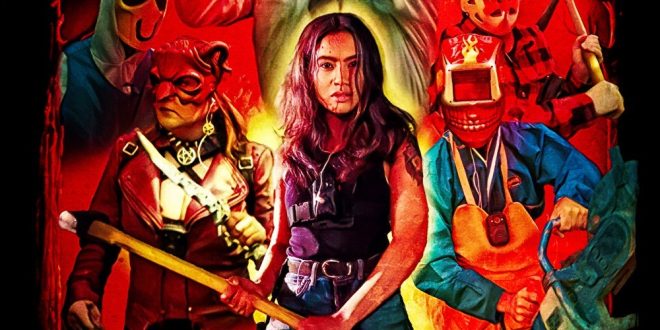Batman: Caped Crusader, the latest animated interpretation of DC’s Dark Knight, embraces the pulpy horror theatrics of EC Comics.
“And you don’t know how to catch a ghost.”
“Before today, I didn’t believe they existed.”
One of superhero media’s greatest luxuries is that it’s an exaggerated genre that frequently toes the line with other styles of story. It’s not unusual for a superhero series to become a political thriller, fantastical rom-com, or epic spaghetti western based on the specific characters who are in play. Batman, in particular, is a classic DC Comics character who’s frequently steeped in dark ideas and he’s someone who’s a natural fit for the horror genre. Each cinematic Batman offering features some degree of horror, even the neon-colored Joel Schumacher entries, and there is no shortage of horror-blending comic stories between Batman: Night Cries, Arkham Asylum: A Serious House on Serious Earth, Batman: Black Mirror, Batman: The Cult, Batman R.I.P., and the radical Batman & Dracula trilogy. Audiences aren’t just comfortable with Batman indulging in horror tropes; they celebrate this twisted, macabre material.
It’s no coincidence that Batman has one of the darkest and most horror-centric rogues’ gallery in DC Comics. Outside the regular terrifying heavy-hitters like Scarecrow, Mad Hatter, Man-Bat, and Black Mask, there’s Doctor Death and his mutating bones, Solomon Grundy, who’s basically a zombie, and a wide run of serial killers that includes the cannibalistic Cornelius Stirk, Professor Pyg and his quest to create the perfect being, and Victor Zsasz, who keeps a running tally of his staggering body count on his own body. All these villains would be perfectly at home as the lead threat in any ‘80s slasher. To go one step further, Batman animated series have been quite welcoming when it comes to telling horror stories that are more interested in getting under the audience’s skin than reflecting the standard superhero-coded tales of bravery, selflessness, and sacrifice.
Batman: The Animated Series, which is often praised as the Holy Grail of Batman cartoons, produced a number of scary episodes. “Eternal Youth” sees Poison Ivy turning people into trees. “Heart of Steel” and “His Silicon Soul” comprise a three-parter with H.A.R.D.A.C. that combines The Terminator, 2001: A Space Odyssey and Invasion of the Body Snatchers through the use of robot doppelgangers. “See No Evil” involves an imaginary friend who turns out to be real and “Moon of the Wolf” pits Batman against a genuine werewolf. Batman Beyond’s “Shriek” also chronicles a twisted scheme that results in Bruce Wayne’s hospitalization and increasingly frayed mental state. These are all standout episodes that further prove the power behind an effective Batman horror story, even if they’re being told in what’s meant to be a cartoon for children.
That being said, Batman: Caped Crusader – Amazon Prime Video’s latest Dark Knight deconstruction and a spiritual successor to Batman: The Animated Series – taps into a very specific brand of old-fashioned pulpy horror. It’s a beautiful fit for a new generation of Batman stories where the public is primed and ready for Elseworlds and “What If?…” experiments.
One of the most striking distinctions about Batman: Caped Crusader is that it’s a Batman series that’s set in the 1940s. The series gets a lot of mileage out of throwing classic Batman characters and staples back nearly a century. However, it also doesn’t seem like a coincidence that the ‘40s marked the start of EC Comics in 1944. The decision to set Batman: Caped Crusader in this specific time period feels like an intentional nod that pays service to EC Comics’ emerging brand of pulp horror, crime, and dark fantasy storytelling. Batman: Caped Crusader doesn’t try to erase its DC Comics touchstones, but it does frequently feel like it’s Batman, as seen through EC Comics, rather than more traditional Batman stories.
EC Comics was a major player in the comics industry during the ‘40s and ‘50s through paradigm-shifting titles like Tales from the Crypt, Vault of Horror, Haunt of Fear, Weird Science, and what was arguably their biggest claim to fame: Mad. EC’s titles gleefully indulged in heightened genre storytelling that routinely put an emphasis on socially conscious and progressive themes, the likes of which were routinely combined with creepy subcultures and sensational ideas. EC Comics titles burned brightly for a decade before 1954’s Comics Code Authority ushered in intense censorship that led to the end of many of EC’s horror and darker genre series. There are plenty of modern comics, television series, and cinema that effectively recapture EC Comics’ lurid sensibilities and trashy tone, such as Tales from the Crypt, Mike Flanagan’s The Midnight Club, or even the CW’s Riverdale.
There are also plenty of modern comic book adaptations that feel indebted to the ‘40s style of EC Comics, but none have felt so explicitly reminiscent of the EC Comics brand as Bruce Timm, Matt Reeves, J.J. Abrams, and Ed Brubaker’s Batman: Caped Crusader. Ed Brubaker is the secret ingredient to this successful recipe and a talented storyteller who has written plenty of Batman, Detective Comics, Gotham Central, as well as someone who has plenty of experience with hard-boiled crime fiction, serial killers, and horror in celebrated works like Houses of the Unholy, Where The Body Was, Criminal, and Kill or Be Killed. He’s a fearless voice who would have excelled in the pages of EC Comics.
In many cases, Batman: Caped Crusader’s villains aren’t hardened criminals. They’re tragic victims of circumstance who become cautionary karmic tales that are akin to the disturbing morality plays that are front and center in so many EC Comics titles, particularly Tales From the Crypt. The only thing that’s missing in Batman: Caped Crusader is the presence of a surreal narrator like the Crypt Keeper or Vault-Keeper who bookends each episode. Such an element would have perhaps felt awkward and foreign to a Batman animated series. However, it’s an idea that still could have worked and would have helped further reinforce that Batman: Caped Crusader is going for a different flavor of storytelling. Harvey Dent playing this role, immersed in shadows so that the audience doesn’t realize that he’s actually been Two-Face the entire time, would have perfectly complemented Batman: Caped Crusader’s narrative arc and the theatrical nature of EC Comics.
Batman: Caped Crusader only has a ten-season episode, unlike Batman: The Animated Series, which produced 85 episodes over two seasons. This certainly limits the number of stories and villains that the series is able to cover. There are many of the usual suspects that are included here, such as The Penguin and Catwoman, but Batman: Caped Crusader features some surprisingly deep cuts for the first season of a Batman show that are specifically calibrated for horror. Gentleman Ghost Jim Craddock is the subject of “Night Ride,” which puts Batman in harm’s way of a genuine ghost. Batman must engage in “old magic” and a blood ritual to quell Craddock’s curse and send him back to the sweet hereafter. Batman’s quest is aided by Linton Midnite, a voodoo priest (and rival to John Constantine), who helps the Dark Knight conquer this sinister specter. The Gentleman Ghost returns to hell in a vicious, gory display, but not before the spirit temporarily possesses Alfred, who attempts to kill Bruce before the spirit is properly exorcised. “Night Ride” features a conclusion that’s very in line with an EC Comics story where Batman: Caped Crusader teases that there are dark, supernatural forces out in the world that can’t be explained.
“Nocturne” is another grim installment that focuses on Natalia “Nocturna” Knight, a succubus-like villain with an extreme sensitivity to sunlight who sustains herself by draining children of their energy. “Nocturne” doesn’t depict the deaths of any children, but it still crafts a veritable boogeyman who lurks in the shadows and is more intense than the many mobsters, burglars, and crime lords who typically tax Batman in the series. This is a villain who defies reality and teases the existence of a much darker world. Curiously, Nocturna was supposed to appear in the original Batman: The Animated Series, albeit as a vampire, but a story that was so focused on the appearance of blood led to it being vetoed by Fox censors. There’s some level of redemption for Timm to finally get to tell a Nocturna story, even if it’s ironically absent of blood. Batman: Caped Crusader’s take on the character proves to be infinitely creepier than any standard vampire story, particularly with a group of missing children in peril and the story’s events playing out against a traveling carnival’s freak show.
Batman: Caped Crusader’s take on more popular and well-known villains, like Clayface, Harley Quinn, and Two-Face, also heavily evoke an EC Comics atmosphere. Clayface has become a rather prominent Batman rogue through recent appearances in Harley Quinn and Suicide Squad Isekai, both of which play into the character’s underlying humor and frivolity. Batman: Caped Crusader strips Clayface of this silliness and instead presents Basil Karlo as a Phantom of the Opera-esque maniac who is lost in tragedy and regret. Batman: Caped Crusader doesn’t treat its characters like jokes, but the EC ethos is also represented through chilling art design, harsh shadows, and macabre scene composition. There’s a moment where a spider crawls onto a victim’s eye and ostensibly becomes their pupil that feels like a splash panel that’s ripped straight from the pages of EC. The same is true for a masterful sequence where Two-Face holds a lit match in the foreground that obscures the damaged half of his face so that he briefly, if only for a moment, looks normal once more. It’s a masterful, pulpy shot that none of the live-action depictions of Two-Face have been able to match.
Finally, Batman: Caped Crusader’s Harley Quinn episode – “The Stress of Her Regard” – effectively stands out as one of the season’s most uncomfortable installments. Harley Quinn is another DC character who has experienced a renaissance in recent years through various creative storytellers, yet none have come close to what’s accomplished here. “The Stress of Her Regard” features one of the most visually distinct reinterpretations of Harley Quinn to date. Batman: Caped Crusader also perverts Harley’s psychology so that she feels reminiscent of Saw’s Jigsaw in terms of the ironic psychological torture that she puts her victims through. Harley doesn’t engage in much physical violence, but she’s still deeply disturbing and intense. Her manipulative presence looms large over the rest of the series and she functions as a helpful reminder that villains don’t need to be phantoms or soul-sucking abominations in order to qualify as one of Gotham’s scariest villains. Harley’s abnormal practices also set up a terrifying take on the Joker for Batman: Caped Crusader’s second season. It’s exciting to consider the horrifying Lon Chaney-esque version of the Clown Prince of Crime that might appear in the series and how Batman: Caped Crusader’s EC Comics influence will affect this iconic villain.
Batman: Caped Crusader’s unique, terrifying take on established corners of the DC universe is sure to resonate with horror fans, comic book aficionados, and everything in between. During a time when comic book culture is at a fever pitch and there’s never been more Batman content on the market, there’s arguably less need for a series like Batman: Caped Crusader. That being said, this saturation point also helps truly groundbreaking and iconoclastic content resonate strongly, especially when there’s a fresh angle to explore. Batman: Caped Crusader’s immersion into EC Comics ideology and a true indulgence in horror is a superpower that’s more fascinating and dangerous than any WayneTech gadget or Kryptonite-powered super-suit.
All ten episodes of ‘Batman: Caped Crusader’ are currently available to stream on Amazon Prime Video


















































































